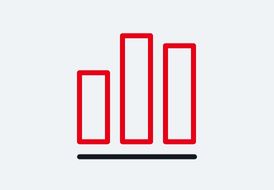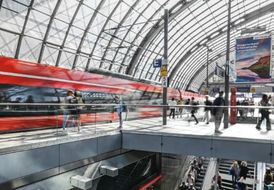Development in the year under review
- The waning negative effects of the Covid-19 pandemic, new transport contracts and 9-Euro-Tickets are the key to the development.
- Increases in energy prices were compensated for by price escalation clauses.
- Operating profit development significantly improved.
DB Regional | 2022 | 2021 | Change | 2019 | |
absolute | % | ||||
Punctuality (rail) (%) | 91.8 | 94.3 | –2.5 | – | 94.3 |
Punctuality (bus) (%) | 86.0 | 83.9 | +2.1 | – | 81.6 |
Customer satisfaction (rail) (SI) | 70.1 | 71.6 | –1.5 | – | 66.1 |
Customer satisfaction (bus 1)) (SI) | 74 | 75 | –1 | – | 73 |
Passengers (million) | 2,072 | 1,540 | +532 | +34.5 | 2,507 |
thereof rail | 1,605 | 1,121 | +484 | +43.2 | 1,972 |
Volume sold (million pkm) | 39,804 | 25,921 | +13,883 | +53.6 | 47,908 |
thereof rail | 34,754 | 21,407 | +13,347 | +62.3 | 41,633 |
Volume produced (rail) (million train-path km) | 433.7 | 426.7 | +7.0 | +1.6 | 452.5 |
Volume produced (bus) (million bus km) | 502.1 | 482.8 | +19.3 | +4.0 | 479.8 |
Total revenues (€ million) | 9,039 | 8,043 | +996 | +12.4 | 8,945 |
External revenues (€ million) | 8,921 | 7,929 | +992 | +12.5 | 8,830 |
Rail concession fees (€ million) | 6,508 | 5,824 | +684 | +11.7 | 5,627 |
EBITDA adjusted (€ million) | 619 | 218 | +401 | – | 1,056 |
EBIT adjusted (€ million) | –31 | –417 | +386 | –92.6 | 408 |
Gross capital expenditures (€ million) | 716 | 480 | +236 | +49.2 | 560 |
Employees as of Dec 31 (FTE) | 37,738 | 37,220 | +518 | +1.4 | 36,374 |
Annual average employees (FTE) | 37,599 | 37,337 | +262 | +0.7 | 36,285 |
Employee satisfaction (SI) | 3.7 | – | – | – | ‒ |
Share of women as of Dec 31 (%) | 16.9 | 17.0 | –0.1 | – | 16.8 |
Specific final energy consumption (rail) compared to 2006 (based on pkm) (%) | –23.8 | +26.3 | –50.1 | – | –30.0 |
Specific final energy consumption (bus) compared to 2006 (based on bus km) (%) | –0.4 | –2.5 | +2.1 | – | +1.7 |
1) Method changed since 2020.
Punctuality in rail transport has dropped. The main causes of this were the high network utilization, capacity restrictions due to the high construction volume and infrastructure disruptions. From June to August 2022, the introduction of the 9-Euro-Ticket also led to a significant increase in excessive stopping times on tourist lines and at weekends in the overall network. The most significant drops in punctuality were recorded in these three months. Capacity bottlenecks combined with a high primary disruption level also led to a significant increase in delays of following trains. The tense personnel situation due to high sick leave in key operational areas also had a negative impact. Punctuality in bus transport has improved, however.
About 26,000 customers (rail) and about 2,300 customers (bus) were surveyed in two waves for the annual customer satisfaction survey:
- DB Regional (rail): Overall passenger satisfaction fell slightly in 2022. While the satisfaction figures for the S-Bahn (metro) (SI of 70) remained stable, a significant decline in regional transport (SI of 70) was observed. Satisfaction with the last journey fell slightly to an SI of 77 (regional services SI of 77 and S-Bahn (metro), SI of 78). The main driver of the deterioration is the development of punctuality and the reliability of the system.
- DB Regional (bus): Customer satisfaction is slightly below the previous year’s level, both in terms of satisfaction with the bus company (SI of 74) and with the current journey (SI of 77), but remains at a good level.
The performance development was very pleasing – in the period from June to August 2022, the pre-Covid-19 level was significantly exceeded as a result of additional stimulus from the introduction of the 9-Euro-Ticket:
- DB Regional (rail): Development in the number of passengers and volume sold was significantly positive primarily as a result of the recovery in demand after the lifting of most measures to contain the Covid-19 pandemic in the first half of 2022. The effects of new transport contracts also exceeded the effects of discontinued transport services.
- DB Regional (bus): Here, too, the negative effects of the Covid-19 pandemic continued to wane. Performance gains had a supporting effect, meaning that the performance development was also very positive.
The economic development of DB Regional remained under pressure, particularly in the bus line of business, due to special effects such as diesel price increases, even though the operating profit figures improved again overall.
In view of the fact that passenger numbers are still lower than pre-Covid levels overall, passenger revenues remain below 2019 levels. Due to the high proportion of gross contracts, the revenue risk lies primarily with the public transport authorities.
Revenue development was positive:
- Revenues: The increase resulted primarily from higher rail concession fees, a demand-driven increase in revenues from fares and performance gains. The loss of revenues from fares in connection with the temporary introduction of the 9-Euro-Ticket partially countered this impact. The compensation for the lost revenues due to the 9-Euro- Ticket is included in other operating income.
- Other operating income: The increase (+4.0%/€ +37 million) due in part to the effects of a change in cost allocation as a result of the introduction of the German Collective Bargaining Agreement (countereffect in the cost of materials), as well as higher income from compensation in connection with delayed vehicle deliveries, among other things. In contrast, Government subsidies, among other things, fell. Here, a decline in Covid-19 support payments, among other things, as a result of the recovery in demand exceeded positive effects, mainly from compensation payments for the 9-Euro-Ticket.
On the expense side, there were additional pressures primarily from demand- and price-related increases in the cost of materials and higher personnel expenses, partly as a result of collective bargaining agreements:
- Cost of materials: The increase in the cost of materials (+8.8%/€ +500 million) mainly due to cost increases for energy, among other things, and higher costs for the use of train-paths and stations in rail transport, partly as a result of higher volume-related costs. In addition, higher expenses for purchased transport services due to price and performance factors led to additional charges.
- Personnel expenses: Noticeable increase (+4.7%/€ +106 million) due in part to the higher number of employees on average.
- Other operating expenses: Slight increase (+3.5%/€ +31 million), due to the rail line of business.
- Depreciation: Also slight increase (+2.4%/€ +15 million).
Capital expenditure activities developed in line with the requirements from transport contracts awarded and rose considerably.
The number of employees increased as of December 31, 2022, driven by the takeover of the Abellio services.
Employee satisfaction has fallen slightly compared with 2020. This was due to the operational challenges, among other things.
The proportion of women was almost at the same level as at the end of the previous year.
In 2022, the specific final energy consumption on rail based on volume sold was lower than in the reference year 2006. One of the drivers of this improvement was the sharp rise in passenger numbers. On the other hand, further measures were taken to improve the energy efficiency of train journeys. The regional energy savings system (RESY) is used in 21 diesel networks. In bus transport, the reduction in specific final energy consumption in relation to volume produced (compared with 2006) was less pronounced than in the previous year, as supply has increased significantly.
- Waning negative effects of Covid-19, new transport contracts and the introduction of the 9-Euro-Ticket are shaping this development.
- Higher costs, especially for personnel, are weighing on development.
- Operating profit development improved significantly.
Rail line of business | 2022 | 2021 | Change | 2019 | |
absolute | % | ||||
Passengers (million) | 1,605 | 1,121 | +484 | +43.2 | 2,010 |
thereof rail | 1,605 | 1,121 | +484 | +43.2 | 1,972 |
Volume sold (million pkm) | 34,754 | 21,407 | +13,347 | +62.3 | 42,204 |
thereof rail | 34,754 | 21,407 | +13,347 | +62.3 | 41,633 |
Volume produced (million train-path km) | 433.7 | 426.7 | +7.0 | +1.6 | 452.5 |
Total revenues (€ million) | 7,878 | 6,965 | +913 | +13.1 | 7,848 |
External revenues (€ million) | 7,769 | 6,859 | +910 | +13.3 | 7,740 |
Rail concession fees (€ million) | 6,508 | 5,824 | +684 | +11.7 | 5,626 |
EBITDA adjusted (€ million) | 698 | 308 | +390 | +127 | 1,037 |
EBIT adjusted (€ million) | 134 | –247 | +381 | – | 454 |
Gross capital expenditures (€ million) | 589 | 341 | +248 | +72.7 | 496 |
Employees as of Dec 31 (FTE) | 28,076 | 27,737 | +339 | +1.2 | 27,715 |
The trend of recovery of demand that began in the previous year continued with the progressive lifting of measures to contain the Covid-19 pandemic in 2022. In addition, the takeover of Abellio transport services and the introduction of the 9-Euro-Ticket had a positive effect on volume sold. As a result, the number of passengers and volume sold rose very significantly. Volume produced increased slightly. Additional transport services in North Rhine-Westphalia and the discontinuation of strike effects from the previous year were partly compensated by construction and personnel-related reductions in the timetable and the discontinuation of transport services of the Hanover S-Bahn (metro).
Operating profit figures also improved considerably. The recovery in performance supported the positive income development:
- Revenues: Increase as a result of higher fare revenues for performance-related reasons and higher concession fees. In addition to general increases by public transport authorities, in particular in connection with an increase in energy prices, new transport services also had an impact here. Transport losses, increased compensation payments due to worse operating quality, the withdrawal of proceeds from fares from the 9-Euro-Ticket (compensation payments included in other operating income) partially compensated for this.
- Other operating income: Development roughly on the previous year’s level:
- Negative effects resulted mainly from lower government subsidies as a result of the recovery in demand. The decline exceeded the increase due to compensation payments for the 9-Euro-Ticket. Lower utilization of provisions for impending losses, which was exceptionally high in the previous year due to Covid-19, also had a negative effect.
- This was offset by the effects of a change in cost allocation as a result of the introduction of the German collective bargaining agreement (countereffect in the cost of materials).
On the expense side, there were additional negative effects, primarily from price effects and additional traffic:
- Cost of materials: The cost of materials rose, mainly as a result of higher costs for energy and volume-related costs for the use of train-paths and stations.
- Personnel expenses: Increase due primarily to a higher average number of employees based on performance and due to collective bargaining agreements.
- Other operating expenses: The increase resulted mainly from the implementation of digitalization measures and measures to tempt more customers to return. Lower additions to provisions for impending losses partially reduced expenses.
- Depreciation: Capital expenditure-related increase. Effects resulting in higher expenses from completed vehicle projects were partially offset by cost-reducing effects from reaching the end of the useful lives of vehicles in the balance sheet.
Capital expenditure activities developed in line with the requirements from transport contracts awarded and was down significantly.
The number of employees increased as a result of the inclusion of the acquired Abellio transport services in particular. Transport losses had the opposite effect.
- Recovery continues after Covid-19-related losses, but has not yet been completed – performance gains had a supporting effect in this case.
- Additional charges due to cost increases.
- Covid-19 support measures continue to have a positive effect.
Bus line of business | 2022 | 2021 | Change | 2019 | |
absolute | % | ||||
Passengers (million) | 467.2 | 418.9 | +48.3 | +11.5 | 496.8 |
Volume sold (million pkm) | 5,049 | 4,515 | +534 | +11.8 | 5,704 |
Volume produced (million bus km) | 502.1 | 482.8 | +19.3 | +4.0 | 452.8 |
Total revenues (€ million) | 1,344 | 1,191 | +153 | +12.8 | 1,162 |
External revenues (€ million) | 1,152 | 1,069 | +83 | +7.8 | 1,090 |
EBITDA adjusted (€ million) | –79 | –91 | +12 | –13.2 | 20 |
EBIT adjusted (€ million) | –165 | –170 | +5 | –2.9 | –46 |
Gross capital expenditures (€ million) | 126 | 139 | –13 | –9.4 | 64 |
Employees as of Dec 31 (FTE) | 9,661 | 9,483 | +178 | +1.9 | 8,659 |
The significantly positive performance development in the bus line of business resulted from the recovery in demand for Covid-19-related restrictions, performance gains and the temporary introduction of the 9-Euro-Ticket.
The operating profit figures improved slightly. However, the economic situation remains challenging.
The positive trend in volumes had an effect on income:
- Revenues: Performance-related increase. The loss of revenues from fares as a result of the introduction of the 9-Euro-Ticket (compensation payments included in other operating income) and the effects of provisions partially offset this.
- Other operating income: The increase was mainly due to the higher utilization of provisions for impending losses and higher Government subsidies (including Covid-19 support payments as part of the local public transport industry solution and compensation payments for the 9-Euro- Ticket).
There were additional negative effects on the expense side, mainly from the cost of materials and personnel expenses:
- Cost of materials: The increase resulted mainly from higher expenses for purchased transport services and higher costs for diesel, due price-related and performance-related factors.
- Personnel expenses: The increase is due to the higher average number of employees and due to collective bargaining agreements.
- Depreciation: Increase due to capital expenditures in the previous year.
In contrast, the decline in other expense items had a dampening effect:
- Other operating expenses: Decrease mainly as a result of lower additions to provisions for impending losses.
Gross capital expenditures fell due to delays in vehicle delivery. Net capital expenditures fell even more sharply due to higher subsidies received (switch to alternative drives).
The number of employees increased for performance-related reasons.


